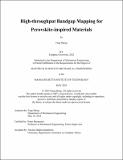High-throughput Bandgap Mapping for Perovskite-inspired Materials
Author(s)
Sheng, Fang
DownloadThesis PDF (17.31Mb)
Advisor
Buonassisi, Tonio
Terms of use
Metadata
Show full item recordAbstract
In recent years, lead halide perovskites have gained attention as promising candidates for photovoltaic devices due to their superior performance. However, issues with stability and toxicity have hindered their widespread application. As a result, perovskite-inspired materials, which are stable and lead-free, have attracted attention. Like their lead halide counterparts, these perovskite-inspired materials possess a vast compositional space, presenting a challenge in finding materials with the desired optoelectronic properties. To address this challenge, there is recent interest to develop high-throughput materials synthesis techniques capable of exploring large materials spaces, culminating in the development of materials-printing platforms capable of synthesizing dozens of candidate materials per minute. However, despite acceleration of sample synthesis, significant delays are faced during sample characterization, due to time-intensive data acquisition and analysis. Additionally, issues concerning poor or unquantified synthesis reproducibility can affect the quality of information gained. In this thesis, I used a home-built high-throughput combinatorial printer to synthesize perovskite-inspired materials and developed a novel high-throughput technique to map local bandgaps with pixel-level resolution. This characterization technique utilizes spatially-resolved reflectance spectra and automated data analysis. I collected approximately a million optical bandgap measurements from the compositional space of Cs₃(BiₓSb₁₋ₓ)₂(Br subscript y I₁₋ subscript y )₉ perovskite-inspired materials in total. The bandgap mapping results revealed nonlinear bandgap variations along six compositional gradient sequences. I was able to identify phase separation within samples by detecting the presence of multiple bandgaps, utilizing extensive spatial and optical data. Finally, I worked with colleagues to obtain transient absorption spectroscopy data, which indicated that carrier depletion from ground states to excited states occurred at distinct energy levels, exhibiting unique carrier dynamics that correspond with observed bandgap variations. Anomalies within quasi-binary systems may indicate phase separation In conclusion, this approach enables rapid screening of quasi-binary phase spaces on the basis of bandgap.
Date issued
2024-05Department
Massachusetts Institute of Technology. Department of Mechanical EngineeringPublisher
Massachusetts Institute of Technology